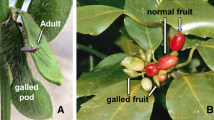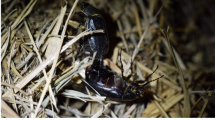Summary
Using a tethered flight technique, migration was studied in the African cotton stainer bugs Dysdercus fasciatus Sign., D. nigrofasciatus Stål, and D. superstitiosus (F.) (Heteroptera: Pyrrhocoridae). The flight system of males of all three species matures in 4–6 days post-eclosion, and flight can continue throughout life. Fed females of D. fasciatus do not fly, but rather histolyse the flight muscles and develop oocytes. Fed females of D. nigrofasciatus and D. superstitiosus exhibit some flight at 4 days post-eclosion, but flight is essentially absent at 6 days when flight muscle histolysis and oögenesis are in progress. Starved females of all three species undertake considerable flight and do not histolyse the flight muscles or develop oöcytes. In starved pairs coupling frequency is lowered permitting increased migration. The three species are thus facultative migrants using starvation as a releasing cue. D. fasciatus feeds on baobab (Adansonia) fruits which are seasonally abundant and is the most opportunistic species with the highest reproductive potential and no flight in the presence of food. D. nigrofasciatus feeds on a variety of herbaceous annuals and perennials; it follows an intermediate migration and reproductive strategy. Finally D. superstitiosus is the most catholic in its food habits and has the lowest reproductive potential. Both of the latter species retain some flight capacity even when fed, presumably so that individuals can locate suitable host plants.
Similar content being viewed by others
References
Arora, G.: A study of oöcyte development in the adult pyrrhocorid bugs of the genus Dysdercus. MSc. Thesis, University of Nairobi (1971).
Ballard, E., Evans, M. G.: Dysdercus sidae Montr. in Queensland. Bull. ent. Res. 18, 405–432 (1928).
Bebbington, A. G., Allan, W.: The food-cycle of Dysdercus fasciatus in Acacia savannah in Northern Rhodesia. Bull. ent. Res. 27, 237–249 (1936).
Berridge, M. J.: The physiology of excretion in the cotton stainer, Dysdercus fasciatus, Signoret IV. Hormonal control of excretion. J. exp. Biol. 44, 553–566 (1966).
Clarke, K. U., Sardesai, J. B.: An analysis of the effects of temperature upon growth and reproduction of Dysdercus fasciatus Sign. (Hemiptera, Pyrrhocoridae). I. The intrinsic rate of increase. Bull. ent. Res. 50, 387–405 (1959).
Cole, L. C.: The population consequences of life history phenomena. Quart. Rev. Biol. 29, 103–137 (1954).
Dingle, H.: The relation between age and flight activity in the milkweed bug, Oncopeltus. J. exp. Biol. 42, 269–283 (1965).
Dingle, H.: The effect of population density on mortality and sex ratio in the milkweed bug, Oncopeltus, and the cotton stainer, Dysdercus (Heteroptera). Amer. Natur. 100, 465–470 (1966a).
Dingle, H.: Some factors affecting flight activity in individual mikweed bugs (Oncopeltus). J. exp. Biol. 44, 335–343 (1966b).
Dingle, H.: Life history and population consequences of density, photoperiod, and temperature in a migrant insect, the milkweed bug Oncopeltus. Amer. Natur. 102, 149–163 (1968).
Dingle, H.: Migration strategies of insects. Science 175, 1327–1335 (1972).
Dingle, H., Caldwell, R. L., Haskell, J. B.: Temperature and circadian control of cuticle growth in the bug Oncopeltus fasciatus. J. Insect Physiol. 15, 373–378 (1969).
Edwards, F. J.: Development and histolysis of the indirect flight muscles in Dysdercus intermedius. J. Insect Physiol. 15, 1591–1599 (1969a).
Edwards, F. J.: Environmental control of flight muscle histolysis in the bug Dysdercus intermedius. J. Insect Physiol. 15, 2013–2020 (1969b).
Geering, Q. A., Coaker, T. H.: The effects of different plant foods on the fecundity, fertility and development of a cotton stainer, Dysdercus superstitiosus (F.). Bull. ent. Res. 51, 61–76 (1960).
Johnson, C. G.: Migration and dispersal of insects by flight. London: Methuen 1969.
Kennedy, J. S.: A turning point in the study of insect migration. Nature (Lond.) 189, 785–791 (1961).
Kennedy, J. S.: Co-ordination of successive activities in an aphid. Reciprocal effects of settling on flight. J. exp. Biol. 43, 489–509 (1965).
Kennedy, J. S.: The balance between antagonistic induction and depression of flight activity in Aphis fabae Scopoli. J. exp. Biol. 45, 215–228 (1966).
Kennedy, J. S., Booth, C. O.: Free flight of aphids in the laboratory. J. exp. Biol. 40, 67–85 (1963a).
Kennedy, J. S., Booth, C. O.: Co-ordination of successive activities in an aphid. The effect of flight on the settling responses. J. exp. Biol. 40, 351–369 (1963b).
Kennedy, J. S., Booth, C. O.: Co-ordination of successive activities in an aphid. Depression of settling after flight. J. exp. Biol. 41, 805–824 (1964).
Levins, R.: Evolution in changing environments. Princeton: Princeton University Press 1968.
Lewontin, R. C.: Selection for colonizing ability. In: Baker, H. G., Stebbins, G. L., eds., The genetics of colonizing species, p. 77–94. New York: Academic Press 1965.
MacArthur, R. H., Wilson, E. O.: The theory of island biogeography. Princeton: Princeton University Press 1967.
Neville, A. C.: Chitin orientation in cuticle and its control. Adv. Insect Physiol. 4, 213–286 (1967).
Odhiambo, T. R.: The effects of mating on egg production in the cotton stainer, Dysdercus fasciatus. Ent. exp. and appl. 11, 379–388 (1968).
Pearson, E. O.: The insect pests of cotton in tropical Africa. London: Commonwealth Institute of Entomology 1958.
Schmutterer, H.: Pests of crops in northeast and central Africa. Stuttgart: Springer 1969.
Siegel, S.: Nonparametric statistics for the behavioral sciences. New York: McGraw-Hill 1956.
Southwood, T. R. E.: Migration of terrestrial arthropods in relation to habitat. Biol. Rev. 37, 171–214 (1962).
Vrydagh, J. M.: Ètude sur la biologie de Dysdercus superstitiosus F. (Hemiptera). Publ. I.N.E.A.C., Ser. Sci. No 24, 19 pp. (1941).
Vrydagh, J. M.: Ètude comparee sur la biologie de Dysdercus nigrofasciatus (Stål), et Dysdercus melanoderes Karsch. Publ. I.N.E.A.C., Ser. Sci. No 31, 32 pp. (1942).
Whitfield, F. G. S.: The bionomics and control of Dysdercus (Hemiptera) in the Sudan. Bull. ent. Res. 24, 301–313 (1933).
Author information
Authors and Affiliations
Rights and permissions
About this article
Cite this article
Dingle, H., Arora, G. Experimental studies of migration in bugs of the genus Dysdercus . Oecologia 12, 119–140 (1973). https://doi.org/10.1007/BF00345512
Received:
Issue Date:
DOI: https://doi.org/10.1007/BF00345512




